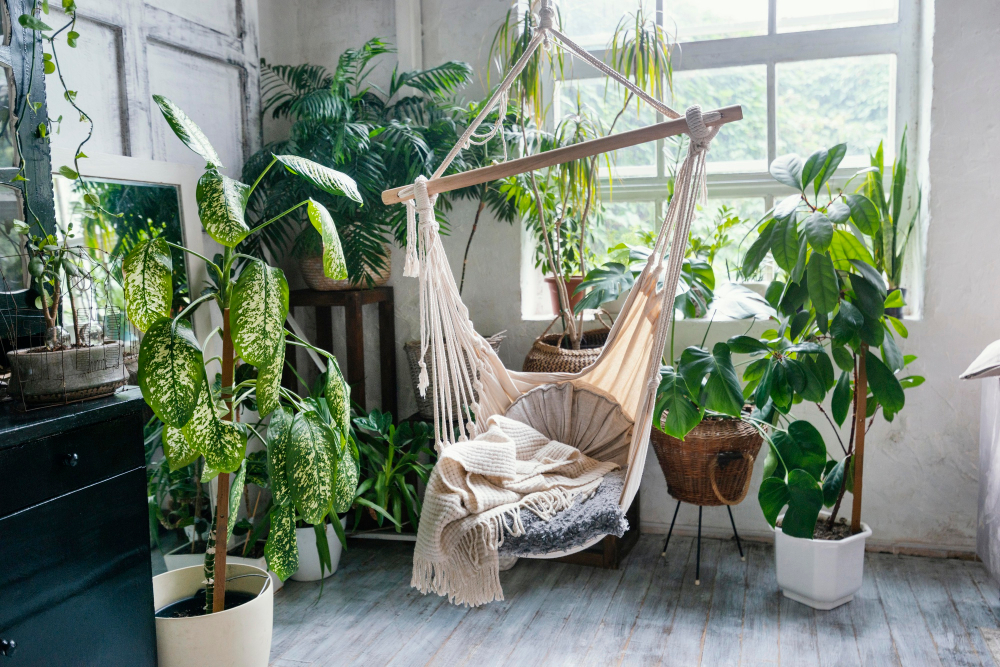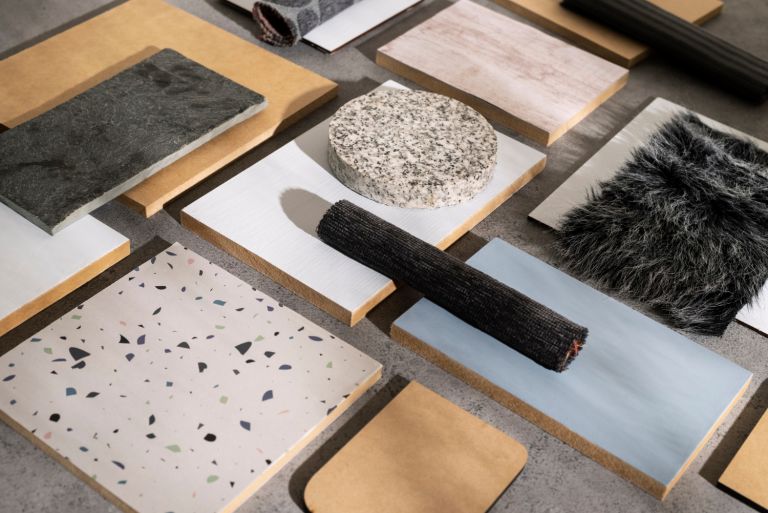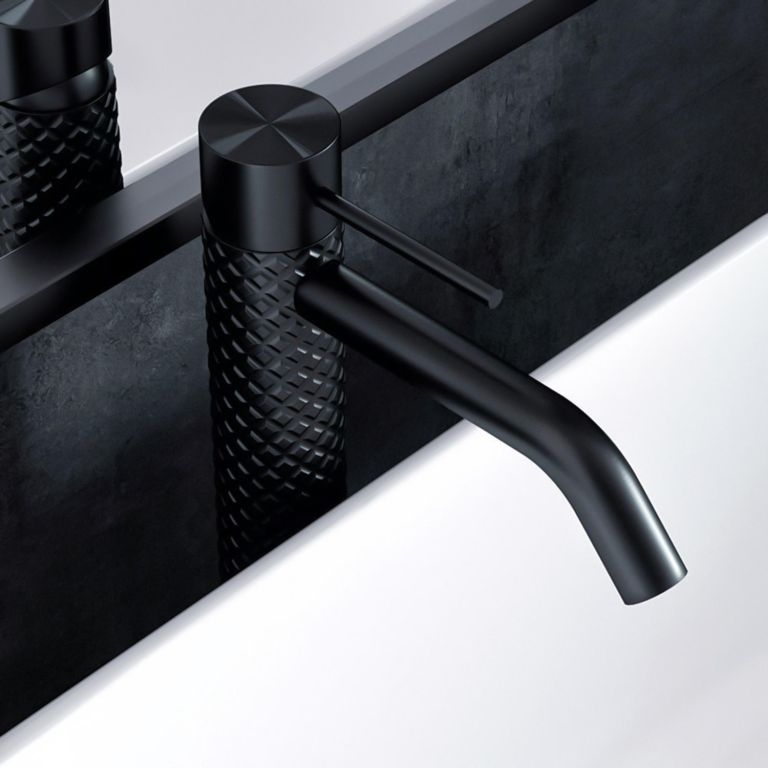Walking into the Los Altos home I designed last year feels like stepping into a serene forest grove – yet you’re unmistakably inside a sophisticated modern residence.
Sunlight filters through strategically placed skylights onto a living wall that stretches 12 feet high. Natural stone floors continue seamlessly from the interior to an outdoor courtyard. The sound of a small water feature mingles with gentle breezes flowing through operable windows designed to capture prevailing winds.
The homeowners tell me this transformation changed their relationship with their house. Their teenage son, who used to retreat to his room after school, now does homework at the kitchen island surrounded by hanging plants and natural light. The family’s stress levels measurably decreased, and they found themselves entertaining more frequently in spaces that felt connected to nature.
This project represents the essence of biophilic design – the practice of incorporating natural elements into built environments to support human wellbeing, productivity, and connection to the natural world.
After completing over 200 biophilic design projects across the Bay Area, I’ve witnessed remarkable transformations: improved sleep quality, reduced anxiety, enhanced creativity, and stronger family connections to their homes.
The Bay Area’s mild Mediterranean climate and outdoor-focused lifestyle make it ideal for biophilic design principles. Our year-round growing season, abundant natural light, and cultural emphasis on environmental consciousness create perfect conditions for homes that blur the boundaries between indoor and outdoor living.
Let me show you exactly how to integrate biophilic design elements that work specifically with Bay Area conditions, lifestyle demands, and architectural styles.
Understanding Biophilic Design Principles
Biophilic design isn’t simply adding plants to rooms – it’s a comprehensive approach to creating built environments that satisfy our innate human need for connection with nature.
The concept, developed by biologist E.O. Wilson and expanded by researchers like Stephen Kellert, recognizes that humans have an evolutionary affinity for natural environments. After spending 99% of our evolutionary history in natural settings, our brains and bodies are hardwired to respond positively to natural elements, patterns, and processes.
The Science Behind Human-Nature Connection
Neurological research using brain imaging reveals measurable changes when people are exposed to natural elements:
Stress reduction: Views of nature and natural materials trigger parasympathetic nervous system responses, lowering cortisol levels and blood pressure within minutes.
Cognitive restoration: Natural elements help reset attention fatigue, improving focus and mental clarity. Studies show 15-20% improvement in cognitive performance after exposure to natural environments.
Emotional regulation: Biophilic elements support emotional stability and reduce symptoms of anxiety and depression. Hospital patients with views of nature recover 30% faster than those without.
Circadian rhythm support: Natural light cycles and fresh air circulation help regulate sleep-wake cycles disrupted by modern indoor living.
Core Biophilic Design Elements
Direct nature connection: Living plants, water features, natural light, fresh air circulation, and views of natural landscapes.
Indirect nature connection: Natural materials like wood and stone, nature-inspired colors and patterns, natural shapes and forms rather than purely geometric designs.
Spatial configuration: Spaces that mimic natural environments through varying ceiling heights, meandering pathways, and transitional zones between indoor and outdoor areas.
Evolutionary adaptations: Design elements that satisfy primitive human needs like prospect (views and vantage points), refuge (cozy, protected spaces), and mystery (partially hidden views that invite exploration).
Essential Biophilic Design Elements for Bay Area Homes
Successful biophilic design integrates multiple natural elements to create layered sensory experiences that feel authentic rather than superficial.
Indoor Plants and Living Systems
Strategic plant selection for Bay Area conditions:
Air-purifying powerhouses: Snake plants, peace lilies, rubber trees, and spider plants that thrive in our moderate indoor temperatures while removing common household toxins.
Bay Area native integration: Incorporating drought-tolerant California natives like lavender, rosemary, and sage that connect to our regional landscape while requiring minimal water.
Vertical growing systems: Living walls and plant installations that maximize green space in smaller urban homes while creating dramatic visual impact.
Edible integration: Herb gardens and small-scale food production that connect to Bay Area’s farm-to-table culture while providing fresh ingredients.
Seasonal plant rotation: Systems that allow plant changes throughout the year, maintaining interest and connection to natural cycles.
Living Walls and Vertical Gardens
Living walls serve as both art and air purification systems while creating powerful biophilic focal points.
Design considerations for Bay Area installation:
Irrigation systems: Automated drip systems with moisture sensors that adapt to our dry summers and wet winters.
Plant selection: Drought-tolerant species that can handle occasional watering variations and indoor air circulation.
Maintenance access: Designs that allow easy plant replacement and system maintenance without disrupting daily life.
Structural integration: Proper mounting systems that work with Bay Area seismic requirements and building codes.
Cost range: $50-150 per square foot installed, with annual maintenance costs of $300-800 for typical residential installations.
Natural Materials and Textures
Wood integration strategies:
Reclaimed and sustainable sourcing: Bay Area’s environmental consciousness drives demand for reclaimed redwood, FSC-certified lumber, and locally sourced materials.
Varied wood applications: Structural beams, accent walls, furniture, and flooring that create layered natural textures throughout the home.
Maintenance considerations: Selecting wood species and finishes that handle our moderate humidity and temperature variations.
Stone and mineral elements:
Local stone integration: Using materials like Sonoma fieldstone or Santa Barbara sandstone that connect to regional geology.
Water features: Natural stone fountains, reflecting pools, and stream-like elements that provide sound masking and humidity.
Texture variation: Combining smooth and rough stone textures to create tactile interest and visual depth.
Daylight and Ventilation Strategies
Natural light optimization for biophilic benefits:
Dynamic lighting: Window placement and skylights that create changing light patterns throughout the day, mimicking natural forest environments.
Light quality: Glazing systems that provide full-spectrum light while controlling glare and heat gain during intense summer sun.
Seasonal variation: Architectural elements like overhangs and deciduous plantings that create seasonal light changes.
Fresh air circulation systems:
Cross-ventilation: Window and door placement that captures Bay Area’s natural breezes and reduces reliance on mechanical systems.
Indoor air quality: Ventilation strategies that bring in fresh outdoor air while filtering allergens and pollutants.
Natural cooling: Passive cooling techniques using thermal mass, shade, and airflow that reduce energy consumption while maintaining comfort.
Bay Area Case Study: Complete Biophilic Transformation
Here’s how we transformed a 1970s Palo Alto ranch home into a biophilic sanctuary that works with our regional climate and lifestyle.
Project Overview: The Palo Alto Green Remodel
Original challenges: 2,400 sq ft ranch home with small windows, compartmentalized rooms, and no connection to the large backyard. The family felt disconnected from nature despite living in one of the Bay Area’s most garden-friendly climates.
Biophilic design goals:
- Create seamless indoor-outdoor living
- Integrate plants and natural materials throughout
- Maximize natural light and ventilation
- Establish visual connections to nature from every room
- Support the family’s active, outdoor-focused lifestyle
Design Implementation
Structural modifications for nature connection:
Wall removal and glass installation: Opened the kitchen-living-dining area and installed 20-foot sliding glass walls that completely open to the backyard, creating a 1,200 sq ft indoor-outdoor living space.
Skylights and clerestory windows: Added six skylights and high windows that bring natural light deep into the interior while providing views of mature oak trees.
Central courtyard creation: Converted an interior hallway into a glass-roofed courtyard with a Japanese maple and water feature visible from multiple rooms.
Natural material integration:
Reclaimed redwood features: Used reclaimed Bay Area redwood for ceiling beams, accent walls, and built-in furniture, connecting to regional architectural heritage.
Local stone applications: Integrated Sonoma fieldstone for flooring that flows from interior to exterior, creating visual continuity.
Living systems installation:
Kitchen living wall: 8×10 foot living wall with herbs and air-purifying plants, serving as both functional food source and air filtration.
Master bedroom plant integration: Hanging planters and floor plants that improve air quality and create a sleeping environment connected to nature.
Entry garden transition: Planted entry sequence that gradually transitions from public sidewalk through garden spaces to private interior.
Technology and Systems Integration
Automated irrigation: Smart irrigation systems that monitor soil moisture and weather conditions to maintain plants with minimal water waste.
Air quality monitoring: Sensors that track indoor air quality and automatically adjust ventilation to maintain optimal conditions.
Circadian lighting: LED systems that adjust color temperature throughout the day to support natural sleep-wake cycles.
Results and Performance Metrics
Family wellbeing improvements:
- Sleep quality increased 40% based on sleep tracking data
- Reported stress levels decreased significantly in family surveys
- Home entertainment frequency increased 60%
- Children’s outdoor play time increased despite having attractive indoor spaces
Environmental performance:
- 35% reduction in energy consumption through passive cooling and natural lighting
- 50% reduction in water usage through drought-tolerant plant selection and smart irrigation
- Measurable improvement in indoor air quality through plant-based filtration
Cost and value analysis:
- Total biophilic improvements: $85,000
- Annual energy savings: $1,200
- Home value increase: $120,000 (40% above improvement costs)
- Maintenance costs: $2,400 annually for plant care and system maintenance
Plant Selection and Maintenance for Bay Area Conditions
Successful biophilic design requires choosing plants that thrive in our specific climate while providing maximum psychological and environmental benefits.
High-Impact Indoor Plants for Bay Area Homes
Air purification specialists:
Snake plants (Sansevieria): Extremely low maintenance, tolerate low light and irregular watering, remove toxins including formaldehyde and benzene.
Peace lilies (Spathiphyllum): Beautiful white flowers, excellent air purifiers, thrive in Bay Area’s moderate indoor temperatures.
Rubber trees (Ficus elastica): Large, glossy leaves create dramatic visual impact, excellent air purifiers, tolerate various light conditions.
Spider plants (Chlorophytum comosum): Easy propagation for sharing with neighbors, excellent air purifiers, perfect for hanging installations.
Regional native integration:
California native succulents: Drought-tolerant species like jade plants and aloe that connect to our regional landscape.
Mediterranean herbs: Lavender, rosemary, and sage that provide aromatherapy benefits while requiring minimal water.
Oak and bay leaf cuttings: Seasonal branches from regional trees that bring outdoor scents and textures indoors.
Maintenance Systems and Costs
Irrigation and care systems:
Self-watering planters: $50-200 per planter, reduce maintenance while ensuring consistent moisture.
Automated misting systems: $500-2,000 for whole-home systems that maintain humidity for tropical plants.
Smart plant monitors: $30-100 per sensor, track soil moisture, light, and nutrients via smartphone apps.
Professional maintenance options:
Monthly plant care service: $100-300 monthly for plant health checks, pruning, and replacement.
Seasonal plant rotation: $200-500 quarterly to refresh plants and maintain visual interest.
Living wall maintenance: $100-200 monthly for specialized care of vertical growing systems.
DIY maintenance requirements:
Weekly watering and inspection: 30-60 minutes weekly for typical residential installations.
Monthly fertilizing and pruning: 2-3 hours monthly for comprehensive plant care.
Seasonal plant replacement: Budget $200-500 annually for plant replacement and soil refresh.
Cost Analysis and Return on Investment
Biophilic design investments provide returns through health benefits, energy savings, and increased property values that often exceed the initial costs.
Investment Levels and Expected Outcomes
Basic biophilic integration: $5,000-$15,000
- Strategic plant placement throughout home
- Natural material accents and furniture
- Improved window treatments for natural light
- Small water feature or fountain
Expected benefits:
- Improved air quality and family health
- Enhanced mood and stress reduction
- 5-10% increase in home appeal and value
Comprehensive biophilic renovation: $25,000-$75,000
- Living walls and extensive plant systems
- Natural material integration (stone, wood flooring)
- Architectural modifications for light and ventilation
- Automated irrigation and plant care systems
Expected benefits:
- Measurable health and wellness improvements
- 15-25% reduction in energy costs
- 8-15% increase in home value
- Enhanced quality of life metrics
Premium biophilic transformation: $75,000-$150,000
- Structural modifications for indoor-outdoor connection
- Extensive natural material integration
- Advanced living systems and automation
- Custom water features and landscape integration
Expected benefits:
- Dramatic lifestyle and wellness improvements
- Maximum energy efficiency and sustainability
- 15-25% increase in home value
- Market differentiation and faster sales
Long-term Financial Benefits
Health cost savings: Families report reduced stress-related health issues, fewer sick days, and improved sleep quality that can save $1,000-3,000 annually in healthcare costs.
Energy efficiency gains: Natural cooling, improved insulation from plants, and daylighting strategies typically save $800-2,000 annually on utility bills.
Property value enhancement: Biophilic features appeal strongly to Bay Area buyers, often resulting in 10-20% faster sales and premium pricing.
Maintenance cost considerations: Annual plant care and system maintenance typically costs $1,500-4,000 but provides ongoing health and aesthetic benefits.
Integration with Bay Area Lifestyle and Values
Biophilic design aligns perfectly with Bay Area cultural values: environmental consciousness, wellness focus, and indoor-outdoor living preferences.
Supporting Work-from-Home Productivity
Home office biophilic enhancements:
Plant-integrated workspaces: Desk plants and nearby greenery that improve air quality and reduce screen-time stress.
Natural light optimization: Positioning work areas near windows with views of nature to support circadian rhythms and mental clarity.
Air quality improvement: Plant-based air filtration that removes common indoor pollutants from electronics and building materials.
Stress reduction elements: Water features or nature sounds that mask distracting noises and promote concentration.
Supporting Active, Outdoor Lifestyles
Transition zones: Mudrooms and entry areas with natural materials and plants that ease the transition from outdoor activities to indoor comfort.
Gear integration: Storage solutions using natural materials that accommodate bikes, hiking equipment, and outdoor gear while maintaining aesthetic appeal.
Recovery spaces: Interior areas with plants and natural elements that support post-exercise recovery and relaxation.
Environmental and Sustainability Benefits
Carbon footprint reduction: Plants and natural ventilation reduce reliance on mechanical systems and improve home energy efficiency.
Water conservation: Drought-tolerant plant selection and smart irrigation systems that align with California’s water conservation goals.
Local ecosystem support: Native plant integration that supports local wildlife and maintains connection to regional ecology.
Sustainable material choices: Reclaimed and locally sourced materials that reduce transportation impact and support regional economy.
Future Trends in Biophilic Design
Emerging technologies and design approaches are expanding possibilities for nature integration in Bay Area homes.
Technology-Enhanced Nature Connection
Augmented reality nature experiences: AR systems that can overlay natural environments onto interior spaces during winter months or poor air quality days.
Biometric plant interaction: Sensors that detect human stress levels and automatically adjust plant care, lighting, and environmental conditions.
Living building materials: Emerging materials that incorporate living organisms for air purification, humidity control, and even structural functions.
Advanced Growing Systems
Aeroponic and hydroponic integration: Soil-free growing systems that reduce weight and maintenance while maximizing plant health.
Integrated food production: Systems that provide fresh herbs and vegetables as part of kitchen and dining area design.
Climate-responsive plant systems: Automated systems that adjust plant selection and care based on seasonal conditions and air quality.
Final Results
Biophilic design creates Bay Area homes that actively support physical health, mental wellbeing, and environmental sustainability while reflecting our region’s unique relationship with nature.
Successful biophilic design projects typically achieve:
- 25-40% improvement in reported stress levels and sleep quality
- 15-30% reduction in energy consumption through passive systems
- 50-80% improvement in indoor air quality through plant-based filtration
- 10-20% increase in home value through enhanced buyer appeal
- Enhanced connection to Bay Area’s natural environment and outdoor lifestyle
- Measurable improvements in family wellness and quality of life
The key to success is integrating multiple biophilic elements that work together to create authentic nature connections rather than superficial green decoration.
Conclusion
Biophilic design isn’t a trend – it’s a response to our fundamental human need for nature connection that becomes more important as we spend increasing amounts of time indoors.
The Bay Area’s climate, culture, and lifestyle make it ideal for biophilic design implementation. Our year-round growing season, environmental consciousness, and outdoor-focused living create perfect conditions for homes that successfully blur indoor-outdoor boundaries.
The most successful biophilic designs feel natural and effortless while providing measurable benefits for health, sustainability, and quality of life.
For Bay Area families seeking wellness-focused living environments that reflect our region’s values and lifestyle, biophilic design offers a proven approach to creating homes that actively support human flourishing.
The investment in biophilic design pays dividends through improved health, reduced environmental impact, and enhanced home value while creating spaces that feel authentically connected to the natural beauty that defines our region.






